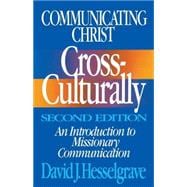
Note: Supplemental materials are not guaranteed with Rental or Used book purchases.
Purchase Benefits
Looking to rent a book? Rent Communicating Christ Cross-Culturally: An Introduction to Missionary Communication [ISBN: 9780310368113] for the semester, quarter, and short term or search our site for other textbooks by David J. Hesselgrave. Renting a textbook can save you up to 90% from the cost of buying.
| CONTENTS | |
| Figures | |
| Foreword to First Edition | |
| Foreword to Revised Edition | |
| Preface | |
| Part I Communication and Mission | |
| 1. Communication, the Missionary Problem Par Excellence | |
| 2. Man, The Communicating Creature | |
| 3. The Legacy of Rhetoric to Christian Communication | |
| 4. Perspectives From the Science of Communication | |
| 5. The Problem of Meaning | |
| 6. Why Do Missionaries Communicate? | |
| Part II Communication and Culture | |
| 7. The Role of Culture in Communication | |
| 8. Christ and His Communicators Confront Culture | |
| 9. Contextualization – Its Theological Roots | |
| 10. Cross-Cultural Communication – Classic Categories and Paradigms | |
| 11. Cross-Cultural Communciation – Contemporary Categories and Paradigms | |
| 12. Respondents of Other Cultures | |
| Part III Worldviews – Ways of Perceiving the World | |
| 13. Worldviews and Cross Cultural Communication | |
| 14. Communicating Christ Into the Naturalist Worldview | |
| 15. Communicating Christ Into the Tribal Worldview | |
| 16. Communicating Christ Into the Hindu-Buddhistic Worldview | |
| 17. Communicating Christ Into a Chinese Worldview | |
| 18. Communicating Christ Into Other Monotheistic Worldviews | |
| 19. Communicating Christ Into the Worldviews of Syncretism and Multireligion | |
| Part IV Cognitive processes – Ways of Thinking | |
| 20. The Importance of How We Know What We Know | |
| 21. Cultural Differences and the Cognitive Process | |
| 22. Conceptual Thinking and the Western Missionary | |
| 23. Communicating Christ in Cultural Areas Where Intuitional Thinking Predominates | |
| 24. Communicating Christ in Cultural Areas Where Concrete Relational Thinking Predominates | |
| Part V Linguistic Forms – Ways of Expressing Ideas | |
| 25. The Importance of Language | |
| 26. Why Bother to Learn the Language? | |
| 27. Learning About Language Learning | |
| 28. What Can We Learn From Languages? | |
| Part VI Behavioral Patterns – Ways of Acting | |
| 29. From Plato and Aristotle to Edward T. Hall | |
| 30. The Missionary and Behavioral Norms | |
| 31. Seven Aspects of the “Behavioral Dimension” | |
| 32. Where the Action Is | |
| Part VII Social Structures – Ways of Interacting | |
| 33. Communicating and Social Orientations | |
| 34. Status and Role | |
| 35. Kinship: Kindred and Lineage | |
| 36. Nonkinship Groupings | |
| 37. Urban and Rural Societies | |
| 38. Free and Totalitarian Societies | |
| Part VIII Media Influence – Ways of Channeling the Message | |
| 39. Media Have Their Own “Messages” | |
| 40. Using Simple Media | |
| 41. Using Syndetic Media | |
| Part IX Motivational Resources – Ways of Deciding | |
| 42. From Persuasion to Elenctics | |
| 43. Psychology, Ethnopsychology, and Mission | |
| 44. Motivation, Decision Making, and Conversion | |
| 45. Receptivity and Missionary Response | |
| Bibliography | |
| Index of Persons | |
| Index of Subjects |
The New copy of this book will include any supplemental materials advertised. Please check the title of the book to determine if it should include any access cards, study guides, lab manuals, CDs, etc.
The Used, Rental and eBook copies of this book are not guaranteed to include any supplemental materials. Typically, only the book itself is included. This is true even if the title states it includes any access cards, study guides, lab manuals, CDs, etc.
Excerpted from Communctg Christ Cross: An Introduction to Missionary Communication by David J. Hesselgrave, David Hesselgrave
All rights reserved by the original copyright owners. Excerpts are provided for display purposes only and may not be reproduced, reprinted or distributed without the written permission of the publisher.